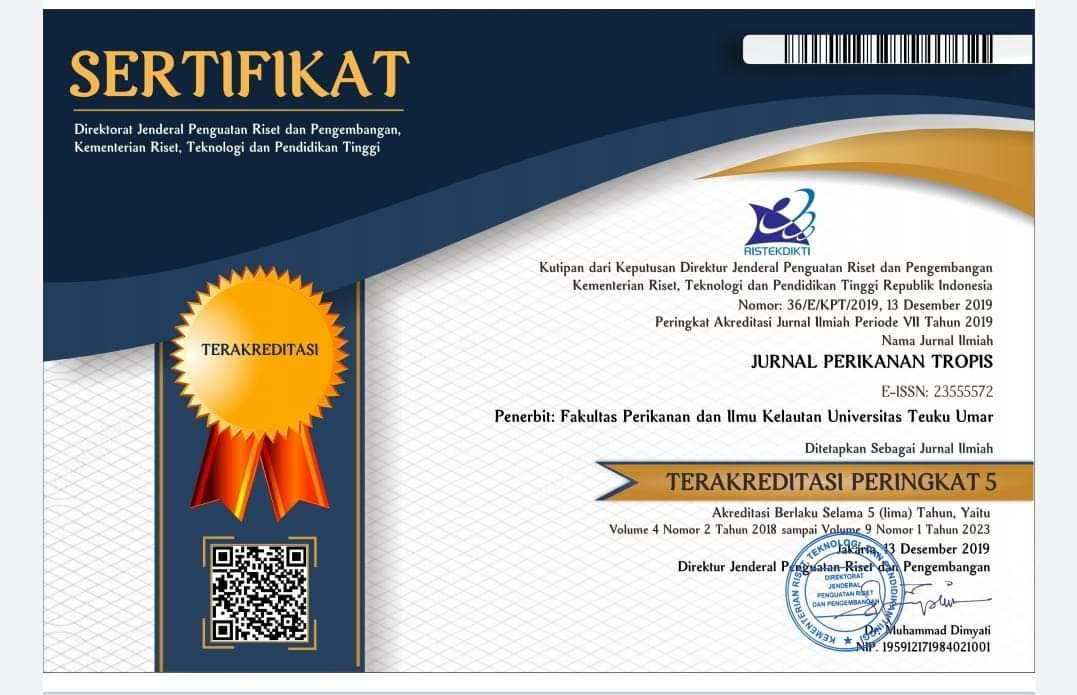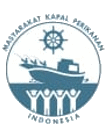DIVERSIFIKASI PENGOLAHAN HASIL LAUT DALAM UPAYA PENCEGAHAN STUNTING DI DESA BABUL MAKMUR KABUPATEN SIMEULUE
Abstract
Simeulue Regency is ranked as the second highest stunting rate among other districts in Aceh Province. One of the villages showing the highest stunting rate is Babul Makmur in West Simeulue District. Therefore, it is necessary to conduct research on the diversification of marine product processing as an effort to prevent stunting in Babul Makmur Village. The research was conducted in Babul Makmur Village from November to December 2021. This study used qualitative methods, namely observation and interviews with 50 respondents. Based on the results, it was found that 78% of respondents had heard of functional food and some processed products from marine products. Then, 32% had known that fishery products are rich in protein, omega 3 and omega 6. The final evaluation showed that 74% of respondents had fully understood that consuming fish and shellfish could prevent malnutrition in children and toddlers. The results obtained indicate that the community had a good understanding of the use of seafood and the diversification of its processed products as an effort to prevent and control stunting in children and toddlers.
Keywords: Diversification, Marine Products, Simeulue Regency, Stunting
Full Text:
PDFReferences
Badan Pusat Statistik. 2015. Simeulue Dalam Angkah 2015. Simeulue.
Black, R.E., Victoria, C.G., Walker. 2013. Kekurangan Gizi Dan Kelebihan Berat Badan Pada Ibu Dan Anak Di Negara-Negara Yang Berpenghasilan Rendah Dan Menengah. Lancet, 382(9890), 427-451.
Burhanis., Alaudin, Edwarsyah, Jaliadi, A. Rozi, Zulfadhli, R. Fadhillah, & Z. Radmi. 2021. Utilization and optimization of the sustainability of yellow fin tuna (Thunnus albacares) in Simeulue waters, Aceh Indonesia. In The International Conference on Sustainable Utilization of Natural Resources. Ambon, 28 Novermber 2020 1-7 p. https://doi.org/10.1088/1755-1315/800/1/012002.
Fargomeli, F. 2014. Interaksi Nelayan Dalam Meningkatkan Taraf Hidup. Jurnal “acta Diurna” Volume III. No.3.
Hirschhon, JS. 1994. Manfaat pendekatan penerapan produksi bersih oleh industri. Indonesia cleaner Industrial Production Program (ICIP). Jakarta
Larsen, R., Eilersten, K.E., Elvevoll, E.O. 2011. Manfaat Makan Dari Laut Dan Bahan-Bahan Nya.Biotechnology Advances, 29,508-518.
Moleong Lexy. J. 2004. Metodologi Penelitian Kualitatif. Penerbit Rosdakarya Bandung.
Serambinews.com, “Aceh Peringkat Tiga Stunting”, diakses melalui https://aceh.tribunnews.com/2019/03/04/aceh-peringkat-tiga-stunting. diakses tanggal 03 Agustus 2020, pukul: 20:15.
Serambinews.com, “Simeulue Urutan 2 Stunting di Aceh Bupati Erli Hasyim Minta Laporan Upaya Penurunan Daeri Dinkes“ diakses melalui https://aceh.tribunnews.com/2019/11/12/simeulue-urutan-12-stunting-di-acehbupati-erli hasyim-minta-laporan-upaya-penurunan-dari-dinkes, tanggal 05 Agustus 2020, pukul 20:25.
Setiawan, B.I. 2012. Optimalisasi Diversifikasi Pangan Guna Mewujudkan Ketahanan Pangan Nasional Yang Berkelanjutan. Majalah Tamnas Edisi 94.
Sudiman, H. 2008. Stunting Atau Pendek: Awal Perubahan Patologis Atau Adaptasi Karena Perubahan Sosial Ekonomi Yang Berkepanjangan. Media Litbang Kesehat.18(1), 33-42.
Sujatha, K., Anitha, J., Senthilkumaar, P. 2013. Kandungan Protein Dan Lipid Total Dalam Jaringan Ikan Yang Dapat Di Makan Dari Pusat Pendaratan Ikan. European Journal Of Experimental Biology.
Welina, W.F. Martha, Katasurya, & Rafilludin, M. 2016. Faktor Resiko Stunting Pada Anak Umur 12-14 Bulan. Semarang : Universitas Diponegoro Fakultas Kesehatan Masyarakat.
World Health Organization. 2010. Indikator Profil Negara Sistem Informasi Laskap Nutrisi(Nlis).Profil Indikatory: Intrepretation Gede. Yang Diunduh Dari Http://Apps.Who,Int/Iris/Bitsream/10665/44397/9789241599955_Eng.Pdf
Zulfadhli., Burhanis, & Edwarsyah. 2018. Sosialisasi teknologi fission sebagai alternatif pembiakan teripang (Holothuria sp) bagi masyarakat Simeulue Aceh. J. Marine Kreatif, 2(2). 33-38 p. https://doi.org/10.35308/jmk.v2i2.2619
DOI: https://doi.org/10.35308/jpt.v9i2.4762
Refbacks
- There are currently no refbacks.
Copyright (c) 2022 Melki Alimon

This work is licensed under a Creative Commons Attribution-NonCommercial-ShareAlike 4.0 International License.
Jurnal Perikanan Tropis (print ISSN 2355-5564 ;online ISSN 2355-5572), is published by the Faculty of Fisheries and Marine Science Universitas Teuku Umar, Indonesia .

This work is licensed under a Creative Commons Attribution-NonCommercial-ShareAlike 4.0 International License





.png)






